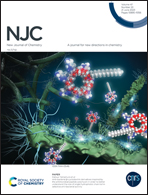Relationship between the structural characteristics of retinal and its visual function—a theoretical study†
Abstract
Vertebrates have evolved to have many options but still share only one retinal chromophore, making their unique structure curious. Here, we studied the relationship between the visual function and its structural characteristics, containing the terminal group C![[double bond, length as m-dash]](https://www.rsc.org/images/entities/char_e001.gif) O, the conjugation length N = 6, and the saturated group CH3. The action of C
O, the conjugation length N = 6, and the saturated group CH3. The action of C![[double bond, length as m-dash]](https://www.rsc.org/images/entities/char_e001.gif) O in the conjugated chain is demarcated by N = 6, which may prevent its appearance in shorter carotenoids. N = 6 guarantees the high stability of the retinal and makes the excited state sensitive to the growth of conjugation length. The electron-withdrawing ability of the saturated group is related to the frontier molecular orbitals, determining its oxidation-reduction ability. Among these, the electronic properties of CH3-saturated retinal are the closest to the H-saturated derivatives. We interpreted the specificity of retinal structure from a new perspective, which provided information for further understanding of the visual mechanism, and laid a foundation for structural improvement and functional expansion of the retinal.
O in the conjugated chain is demarcated by N = 6, which may prevent its appearance in shorter carotenoids. N = 6 guarantees the high stability of the retinal and makes the excited state sensitive to the growth of conjugation length. The electron-withdrawing ability of the saturated group is related to the frontier molecular orbitals, determining its oxidation-reduction ability. Among these, the electronic properties of CH3-saturated retinal are the closest to the H-saturated derivatives. We interpreted the specificity of retinal structure from a new perspective, which provided information for further understanding of the visual mechanism, and laid a foundation for structural improvement and functional expansion of the retinal.



 Please wait while we load your content...
Please wait while we load your content...